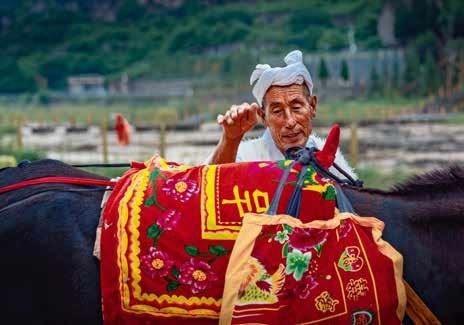一壶煮沸黄河水
飞扬
在山西省和陕西省交界的晋陕大峡谷中,黄河缓缓流淌过北方大地。当河水到达山西吉县和陕西宜川县交界处时,河床突然降低,上游300米宽的黄河水面在不到500米的距离内,骤然收缩到20至30米的宽度,河道被收缩成壶口的形状。此时,河水以每秒1000立方米的速度,从20余米高的断层石崖飞泻直下,跌入30余米宽、约 20米深的石槽之中,掀起腾空黄浪,排山倒海、震天撼地。听之如万马奔腾,视之如巨壶沸腾,故名“壶口瀑布”,是黄河上唯一的黄色大瀑布,也是中国的第二大瀑布。因两岸的岩石长期受流水冲刷和打磨,瀑布以平均每年0.5米的速度不断向上游退移。近年来,由于人们对水土流失进行了有效治理,黄河上游两岸植被增加,黄河水裹挟的泥沙在逐渐减少,壶口瀑布位置变化的速度也在逐年放慢。
壶口瀑布东岸是山西省临汾市吉县壶口镇,西岸则属陕西省延安市宜川县壶口乡。壶口瀑布由于四季气候和水量的变化,不同季节有着不同的风姿。春季冰雪融化,水量适度平稳,主瀑、副瀑连成一片,烟雾缭绕,千流竞争。夏秋千溪万壑之水汇聚,流量猛增,主瀑、副瀑携手倾泻,浩浩荡荡。冬天冰封河面,冰凌匯集,晶莹剔透,像是一座美丽的水晶宫。一年四季景色各异,造就了水底冒烟、旱地行船、霓虹戏水、晴空洒雨、旱天鸣雷、冰封倒挂、山飞海立、十里龙槽八大景观,让人惊叹。
抗日战争时期,革命诗人光未然、音乐家冼星海,就是在这黄河壮丽情景的激励下,谱写出鼓舞人民斗志的《黄河大合唱》。如今,每天都有游客和研学团队从各地奔赴这里,观壶口瀑布,听黄河涛声,追寻抗战先辈的英雄事迹,感受危难之际的民族情怀,从伟大的母亲河中汲取精神力量。



Boiling a Pot of Yellow River Water
In the Shanxi-Shaanxi Grand Canyon on the border of Shanxi and Shaanxi provinces, the Yellow River flows slowly through the northern landscape. When the river water flows reaches the junction of Ji County in Shanxi province and Yichuan County in Shaanxi province, the river channel suddenly drops, and the surface of the Yellow River, 300 meters wide upstream, suddenly shrinks to a width of 20 to 30 meters in less than 500 meters, and the watercourse shrinks into the shape of a pot mouth.
At this time, the river water falls into a stone trough more than 30 meters wide and about 20 meters deep at a speed of 1,000 cubic meters per second from a fault in the cliff more than 20 meters high. It sets off a yellow wave, like a giant pot boiling, so it is named“Hukou Waterfall”. It’s the only yellow waterfall on the Yellow River, and is also the second largest waterfall in China. Due to the longterm erosion and polishing of the rocks on both sides, the waterfall continues to retreat upstream at an average rate of 0.5 meters per year. In recent years, due to the effective control of water and soil loss, the vegetation on both sides of the upper reaches of the Yellow River has gradually decreased, and the speed of change in the location of the Hukou Waterfall has slowed down year by year.
Hukou Waterfall has different styles in different seasons due to the change of climate and water volume throughout the year. In spring, as the ice and snow melt, the water volume is moderately stable, the main waterfall and the secondary waterfall are connected, the smoke is shrouded, and thousands of streams compete. In summer and autumn, as the waters of the Qianxi and Wanhe converge, the water volume soars, and the main waterfall and the secondary waterfall come together, going forward with great strength and vigour. In winter, the rivers are frozen, like a beautiful clear crystal palace.
During the War of Resistance against Japan, the revolutionary poet Guang Weiran and the musician Sinn Sing Hoi were inspired by this magnificent scene of the Yellow River to compose the The Yellow River Cantata that inspired the people’s fighting spirit.

